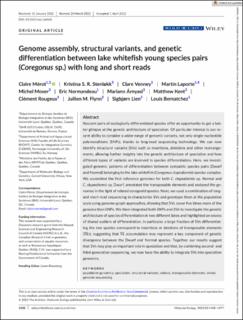| dc.contributor.author | Mérot, Claire | |
| dc.contributor.author | Stenløkk, Kristina Severine Rudskjær | |
| dc.contributor.author | Venney, Clare | |
| dc.contributor.author | Laporte, Martin | |
| dc.contributor.author | Moser, Michel | |
| dc.contributor.author | Normandeau, Eric | |
| dc.contributor.author | Arnyasi, Mariann | |
| dc.contributor.author | Kent, Matthew Peter | |
| dc.contributor.author | Rougeux, Clément | |
| dc.contributor.author | Flynn, Jullien | |
| dc.contributor.author | Lien, Sigbjørn | |
| dc.contributor.author | Bernatchez, Louis | |
| dc.date.accessioned | 2023-03-22T10:23:39Z | |
| dc.date.available | 2023-03-22T10:23:39Z | |
| dc.date.created | 2022-05-09T09:36:11Z | |
| dc.date.issued | 2022 | |
| dc.identifier.citation | Molecular Ecology. 2022, 32 (6), 1458-1477. | |
| dc.identifier.issn | 0962-1083 | |
| dc.identifier.uri | https://hdl.handle.net/11250/3059794 | |
| dc.description.abstract | Nascent pairs of ecologically differentiated species offer an opportunity to get a better glimpse at the genetic architecture of speciation. Of particular interest is our recent ability to consider a wider range of genomic variants, not only single-nucleotide polymorphisms (SNPs), thanks to long-read sequencing technology. We can now identify structural variants (SVs) such as insertions, deletions and other rearrangements, allowing further insights into the genetic architecture of speciation and how different types of variants are involved in species differentiation. Here, we investigated genomic patterns of differentiation between sympatric species pairs (Dwarf and Normal) belonging to the lake whitefish (Coregonus clupeaformis) species complex. We assembled the first reference genomes for both C. clupeaformis sp. Normal and C. clupeaformis sp. Dwarf, annotated the transposable elements and analysed the genomes in the light of related coregonid species. Next, we used a combination of long- and short-read sequencing to characterize SVs and genotype them at the population scale using genome-graph approaches, showing that SVs cover five times more of the genome than SNPs. We then integrated both SNPs and SVs to investigate the genetic architecture of species differentiation in two different lakes and highlighted an excess of shared outliers of differentiation. In particular, a large fraction of SVs differentiating the two species correspond to insertions or deletions of transposable elements (TEs), suggesting that TE accumulation may represent a key component of genetic divergence between the Dwarf and Normal species. Together, our results suggest that SVs may play an important role in speciation and that, by combining second- and third-generation sequencing, we now have the ability to integrate SVs into speciation genomics. | |
| dc.language.iso | eng | |
| dc.relation.uri | https://onlinelibrary.wiley.com/doi/full/10.1111/mec.16468 | |
| dc.subject | Bioinformatikk | |
| dc.subject | Bioinformatics | |
| dc.title | Genome assembly, structural variants, and genetic differentiation between lake whitefish young species pairs (Coregonus sp.) with long and short reads | |
| dc.title.alternative | Genome assembly, structural variants, and genetic differentiation between lake whitefish young species pairs (Coregonus sp.) with long and short reads | |
| dc.type | Peer reviewed | |
| dc.type | Journal article | |
| dc.description.version | publishedVersion | |
| dc.subject.nsi | VDP::Matematikk og naturvitenskap: 400 | |
| dc.subject.nsi | VDP::Mathematics and natural scienses: 400 | |
| dc.source.pagenumber | 1458-1477 | |
| dc.source.volume | 32 | |
| dc.source.journal | Molecular Ecology | |
| dc.source.issue | 6 | |
| dc.identifier.doi | 10.1111/mec.16468 | |
| dc.identifier.cristin | 2022547 | |
| dc.relation.project | Internasjonale institusjoner: Natural Sciences and Engineering Research Council of Canada | |
| dc.relation.project | Internasjonale institusjoner: Ressources Aquatiques Québec (RAQ) | |
| cristin.ispublished | true | |
| cristin.fulltext | original | |
| cristin.qualitycode | 2 | |
